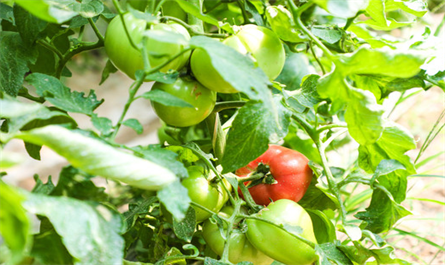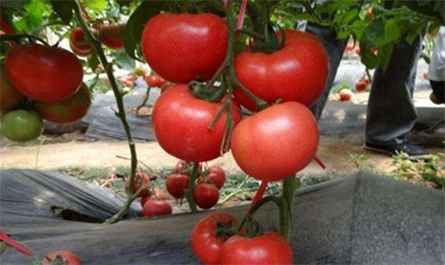Application of plant growth regulators on vegetables - Tomato
Tomato has the biological characteristics of being warm, light-loving, fertilizer-tolerant and semi-drought-tolerant. It grows well in climate conditions with warm climate, sufficient light, in few cloudy and rainy days, it is easy to obtain high yields. However, high temperature, rainy weather, and insufficient light often cause weak growth. , the disease is serious.


1. Germination
In order to increase the seed germination speed and germination rate, and make the seedlings neat and strong, you can generally use Gibberellic acid(GA3) 200-300 mg/L and soak the seeds for 6 hours, compound sodium nitrophenolate(ATN) 6-8 mg/L and soak the seeds for 6 hours, and diacetate 10-12 mg/ This effect can be achieved by soaking seeds for 6 hours.
2. Promote rooting
Use Pinsoa root king.It can promote root growth and development, thereby cultivating strong seedlings.
3. Prevent excessive growth in the seedling stage
In order to prevent the seedlings from growing too long, make the internodes shorter, the stems thicker, and the plants shorter and stronger, which will facilitate the differentiation of flower buds and thus lay the foundation for increasing production in the later period, the following plant growth regulators can be use.
Chlorocholine chloride(CCC)
(1) Spray method: When there are 2-4 true leaves, 300mg/L spray treatment can make the seedlings short and strong and increase the number of flowers.
(2) Root watering: When the root grow 30-50cm after transplanting, watering the roots with 200mL of 250mg/L Chlorocholine chloride(CCC) for each plant, which can effectively prevent the tomato plants from growing too much.
(3) Root soaking: Soaking roots with Chlorocholine chloride(CCC) 500mg/L for 20 minutes before planting can improve the quality of seedlings, promote flower bud differentiation, and facilitate early maturity and high yield.
Please note when using: Chlorocholine chloride(CCC) is not suitable for weak seedlings and thin soil; the concentration cannot exceed 500mg/L.
For leggy seedlings, foliar spraying of 10-20mg/L paclobutrazol(Paclo) with 5-6 true leaves can effectively control vigorous growth, strong seedlings and promote axillary bud germination.
Note when using: Strictly control the concentration, spray finely, and do not spray repeatedly; prevent the liquid from falling into the soil, avoid root application, and prevent residue in the soil.
4. Prevent flowers and fruits from falling.
In order to prevent flower and fruit drop cause by poor flower development under low or high temperature conditions, the following plant growth regulators can be use:
Naphthylacetic acid(NAA) is sprayed on the leaves with 10 mg/L Naphthylacetic acid(NAA)
Compound sodium nitrophenolate(ATN) should be sprayed on the leaves with 4-6mg/L
The above treatments can effectively prevent flower and fruit drop, accelerate fruit enlargement, and increase early yield.
5. Delay aging and increase production
In order to suppress seedling damping-off and the occurrence of anthracnose, blight and viral diseases in the later stage, cultivate strong seedlings, increase the fruit setting rate in the middle and late stages, increase the fruit shape and production, delay the aging of the plant, and extend the harvest period, can be treated with the following plant growth regulators:
(DA-6)Diethyl aminoethyl hexanoate : Use 10mg/L of ethanol for foliar spraying at the seedling stage, every 667m⊃2; use 25-30kg of liquid. In the field stage, 12-15 mg/L of DA-6 be use for foliar spraying, every 667m⊃2; 50kg of the solution can be use, and the second spray can be done after 10 days, total need 2 sprays.
Brassinolide: Use 0.01mg/L brassinolide for foliar spraying in the seedling stage, every 667m⊃2; use 25-30kg of liquid. In the field stage, 0.05 mg/L brassinolide is use for foliar spraying, every 667 m⊃2; use 50 kg of the solution, and spray the second time every 7-10 days, total need 2 sprays.
6.Promote early ripening of tomatoes
Ethephon: Ethephon is use in tomatoes during the harvest period to promote early ripening of the fruit. It has been widely use in production and has remarkable effects.
It not only can ripen early and increase early yield, but is also very beneficial to the ripening of later tomatoes.
For storage and processing tomato varieties, in order to facilitate centralized processing, all can be treated with ethephon, and the contents of lycopene, sugar, acid, etc. in tomatoes treated with ethephon are similar to those of normal mature fruits.
How to use it:
(1) Smearing method:
When the tomato fruits are about to enter the coloring period (tomatoes turn white) from the green and mature stage, you can use a small towel or gauze gloves to soak in 4000mg/L ethephon solution, and then apply it on the tomato fruits. Just wipe or touch it. The fruits treated with ethephon can mature 6-8 days earlier, and the fruits will be bright and shiny.
(2) Fruit soaking method:
If tomatoes that have entered the color-inducing period are picked and then ripened, 2000 mg/L ethephon can be used to spray the fruits or soak the fruits for 1 minute, and then place the tomatoes in a warm place (22 -25℃) or indoor ripening, but the ripened fruits are not as bright as those on the plants.
(3)Field fruit spraying method:
For one-time harvested processed tomatoes, in the late growth period, when most of the fruits have turned red but some green fruits cannot be used for processing, in order to accelerate the fruit maturity, 1000 mg/L ethephon solution can be sprayed on the whole plant to speed up the ripening of green fruits.
For autumn tomatoes or alpine tomatoes cultivate in the late season, the temperature gradually drops during the late growth period. To prevent frost, ethephon can be spray on the plants or fruits to promote early ripening of the fruits.


1. Germination
In order to increase the seed germination speed and germination rate, and make the seedlings neat and strong, you can generally use Gibberellic acid(GA3) 200-300 mg/L and soak the seeds for 6 hours, compound sodium nitrophenolate(ATN) 6-8 mg/L and soak the seeds for 6 hours, and diacetate 10-12 mg/ This effect can be achieved by soaking seeds for 6 hours.
2. Promote rooting
Use Pinsoa root king.It can promote root growth and development, thereby cultivating strong seedlings.
3. Prevent excessive growth in the seedling stage
In order to prevent the seedlings from growing too long, make the internodes shorter, the stems thicker, and the plants shorter and stronger, which will facilitate the differentiation of flower buds and thus lay the foundation for increasing production in the later period, the following plant growth regulators can be use.
Chlorocholine chloride(CCC)
(1) Spray method: When there are 2-4 true leaves, 300mg/L spray treatment can make the seedlings short and strong and increase the number of flowers.
(2) Root watering: When the root grow 30-50cm after transplanting, watering the roots with 200mL of 250mg/L Chlorocholine chloride(CCC) for each plant, which can effectively prevent the tomato plants from growing too much.
(3) Root soaking: Soaking roots with Chlorocholine chloride(CCC) 500mg/L for 20 minutes before planting can improve the quality of seedlings, promote flower bud differentiation, and facilitate early maturity and high yield.
Please note when using: Chlorocholine chloride(CCC) is not suitable for weak seedlings and thin soil; the concentration cannot exceed 500mg/L.
For leggy seedlings, foliar spraying of 10-20mg/L paclobutrazol(Paclo) with 5-6 true leaves can effectively control vigorous growth, strong seedlings and promote axillary bud germination.
Note when using: Strictly control the concentration, spray finely, and do not spray repeatedly; prevent the liquid from falling into the soil, avoid root application, and prevent residue in the soil.
4. Prevent flowers and fruits from falling.
In order to prevent flower and fruit drop cause by poor flower development under low or high temperature conditions, the following plant growth regulators can be use:
Naphthylacetic acid(NAA) is sprayed on the leaves with 10 mg/L Naphthylacetic acid(NAA)
Compound sodium nitrophenolate(ATN) should be sprayed on the leaves with 4-6mg/L
The above treatments can effectively prevent flower and fruit drop, accelerate fruit enlargement, and increase early yield.
5. Delay aging and increase production
In order to suppress seedling damping-off and the occurrence of anthracnose, blight and viral diseases in the later stage, cultivate strong seedlings, increase the fruit setting rate in the middle and late stages, increase the fruit shape and production, delay the aging of the plant, and extend the harvest period, can be treated with the following plant growth regulators:
(DA-6)Diethyl aminoethyl hexanoate : Use 10mg/L of ethanol for foliar spraying at the seedling stage, every 667m⊃2; use 25-30kg of liquid. In the field stage, 12-15 mg/L of DA-6 be use for foliar spraying, every 667m⊃2; 50kg of the solution can be use, and the second spray can be done after 10 days, total need 2 sprays.
Brassinolide: Use 0.01mg/L brassinolide for foliar spraying in the seedling stage, every 667m⊃2; use 25-30kg of liquid. In the field stage, 0.05 mg/L brassinolide is use for foliar spraying, every 667 m⊃2; use 50 kg of the solution, and spray the second time every 7-10 days, total need 2 sprays.
6.Promote early ripening of tomatoes
Ethephon: Ethephon is use in tomatoes during the harvest period to promote early ripening of the fruit. It has been widely use in production and has remarkable effects.
It not only can ripen early and increase early yield, but is also very beneficial to the ripening of later tomatoes.
For storage and processing tomato varieties, in order to facilitate centralized processing, all can be treated with ethephon, and the contents of lycopene, sugar, acid, etc. in tomatoes treated with ethephon are similar to those of normal mature fruits.
How to use it:
(1) Smearing method:
When the tomato fruits are about to enter the coloring period (tomatoes turn white) from the green and mature stage, you can use a small towel or gauze gloves to soak in 4000mg/L ethephon solution, and then apply it on the tomato fruits. Just wipe or touch it. The fruits treated with ethephon can mature 6-8 days earlier, and the fruits will be bright and shiny.
(2) Fruit soaking method:
If tomatoes that have entered the color-inducing period are picked and then ripened, 2000 mg/L ethephon can be used to spray the fruits or soak the fruits for 1 minute, and then place the tomatoes in a warm place (22 -25℃) or indoor ripening, but the ripened fruits are not as bright as those on the plants.
(3)Field fruit spraying method:
For one-time harvested processed tomatoes, in the late growth period, when most of the fruits have turned red but some green fruits cannot be used for processing, in order to accelerate the fruit maturity, 1000 mg/L ethephon solution can be sprayed on the whole plant to speed up the ripening of green fruits.
For autumn tomatoes or alpine tomatoes cultivate in the late season, the temperature gradually drops during the late growth period. To prevent frost, ethephon can be spray on the plants or fruits to promote early ripening of the fruits.
RECENT POSTS
-
Using Plant Growth Regulators to Improve Celery Yield and Quality
-
How to correctly use plant growth regulators in vegetable production?
-
Application Effects and Methods of Prohexadione Calcium in Garlic Cultivation
-
DA-6 application methods for potatoes sweet potatoes and ginger during their tuber expansion phase
Featured News



